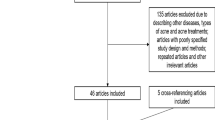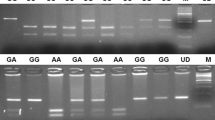Abstract
Acne vulgaris is a skin disorder with a complex pathogenesis. Better treatment strategies require comprehensive knowledge of molecular factors contributing to the acne pathophysiology. Recent studies are focused on investigating the influence of inflammatory cytokines on the disease. This case–control study investigated the association of IL-6-572 G/C and IL-1A-889 C/T gene polymorphisms with acne in a Pakistani population. Pakistani subjects (380 healthy controls and 430 acne patients) were enrolled in this study. Polymorphism in the promoter region of IL-6-572 and IL-1A-889 was determined by polymerase chain reaction and restriction fragment length polymorphism. The IL-6-572 and IL-1A-889 variant genotypes were significantly associated with the acne pathogenesis. The IL-6-572C and the IL-1A-889T alleles were significantly high in the patient vs. control group (p < 0.0001 for both loci). The IL-6-572 G/C and IL-1A-889 C/T variant allele haplotypes showed significantly high prevalence in patients with acne; G-T (P = 0.0014), C-C (P < 0.0001), and C-T (P < 0.0001). This is the first report on the association between the IL-6-572 G/C polymorphism and acne among any population. The IL-1A-889 C/T polymorphism is also significantly linked with acne in the study population; the -889 C/T association with acne has been reported in one ethnic group previously. Our findings suggest that the IL-6-572C and IL-1A-889T alleles may contribute to the pathogenesis of acne in a Pakistani population. Further studies are required to verify these findings in other populations.
Similar content being viewed by others
References
Aldana OL, Holland DB, Cunliffe WJ (1998) Variation in pilosebaceous duct keratinocyte proliferation in acne patients. Dermatology 196:98–99
Antilla HS, Reitamo S, Saurat JH (1992) Interleukin 1 immunoreactivity in sebaceous glands. Br J Dermatol 127:585–588
Baz K, Emin EM, Yazici AC, Söylemez F, Güvenç U, Taşdelen B, Ikizoğlu G (2008) Association between tumor necrosis factor-alpha gene promoter polymorphism at position -308 and acne in Turkish patients. Arch Dermatol Res 300:371–376
Brull DJ, Montgomery HE, Sanders J, Dhamrait S, Luong L, Rumley A, Lowe GD, Humphries SE (2001) Interleukin-6 gene -174G > C and -572G > C promoter polymorphisms are strong predictors of plasma interleukin-6 levels after coronary artery bypass surgery. Arterioscler Thromb Vasc Biol 21:1458–1463
Degitz K, Placzek M, Borelli C, Plewig G (2007) Pathophysiology of acne. J Dtsch Dermatol Ges 4:316–323
Dominici R, Cattaneo M, Malferrari G, Archi D, Mariani C, Grimaldi LM, Biunno I (2002) Cloning and functional analysis of the allelic polymorphismin the transcription regulatory region of interleukin-1. Immunogenetics 54:82–86
Downie MM, Sanders DA, Kealey T (2002) Modelling the remission of individual acne lesions in vitro. Br J Dermatol 147:869–878
Ferrari SL, Ahn-Luong L, Garnero P, Humphries SE, Greenspan SL (2003) Two promoter polymorphisms regulating interleukin-6 gene expression are associated with circulating levels of C-reactive protein and markers of bone resorption in postmenopausal women. J Clin Endocrinol Metab 88:255–259
Fishman D, Faulds G, Jeffery R, Mohamed-Ali V, Yudkin JS, Humphries S, Woo P (1998) The effect of novel polymorphism in the interleukin-6 (IL-6) gene on IL-6 transcription and plasma IL-6 levels, and an association with systemic-onset juvenile chronic arthritis. J Clin Invest 102:1369–1376
Foster CB, Lehrnbecher T, Samuels S, Stein S, Mol F, Metcalf JA, Wyvill K, Steinberg SM, Kovacs J, Blauvelt A, Yarchoan R, Chanock SJ (2000) An IL6 promoter polymorphism is associated with a lifetime risk of development of Kaposi sarcoma in men infected with human immunodeficiency virus. Blood 96:2562–2567
Ghazouani L, Abboud N, Ben Hadj Khalifa S, Added F, Ben Khalfallah A, Nsiri B, Mediouni M, Mahjoub T (2011) 174 G/C Interleukin-6 gene polymorphism in Tunisian patients with coronary artery disease. Ann Saudi Med 31:40–44
Hussain S, Bibi S, Javed Q (2011) Heritability of genetic variants of resistin gene in patients with coronary artery disease: a family-based study. Clin Biochem 44:618–622
Ingham E, Eady EA, Goodwin CE, Cove JH, Cunliffe WJ (1992) Pro-inflammatory levels of interleukin-1a-like bioactivity are present in the majority of open comedones in acne vulgaris. J Invest Dermatol 98:895–901
Jeremy AH, Holland DB, Roberts SG, Thomson KF, Cunliffe WJ (2003) Inflammatory events are involved in acne lesion initiation. J Invest Dermatol 121:20–27
Kishimoto T (1989) The biology of interleukin-6. Blood 74:1–10
Kobayashi Y, Yamamoto K, Saido T et al (1990) Identification of calcium-activated neutral protease as a processing enzyme of human interleukin 1 alpha. Proc Natl Acad Sci USA 87:5548–5552
Koreck A, Pivarcsi A, Dobozy A, Kemeny L (2003) The role of innate immunity in the pathogenesis of acne. Dermatology 206:96–105
Lehmann HP, Robinson KA, Andrews JS, Holloway V, Goodman SN (2002) Acne therapy: a methodologic review. J Am Acad Dermatol 47:231–240
Leyden JJ (1997) Therapy for acne vulgaris. N Engl J Med 336:1156–1162
Mälarstig A, Wallentin L, Siegbahn A (2007) Genetic variation in the interleukin-6 gene in relation to risk and outcomes in acute coronary syndrome. Thromb Res 119:467–473
Sambrook J, Fritsch EF, Maniatis T (1989) Molecular cloning: A laboratory manual, 2nd edn. Cold Spring Harbor Laboratory Press, New York
Sen A, Paine SK, Chowdhury IH, Mukherjee A, Choudhuri S, Saha A, Mandal LK, Bhattacharya B (2011) Impact of interleukin-6 promoter polymorphism and serum interleukin-6 level on the acute inflammation and neovascularization stages of patients with Eales’ disease. Mol Vis 17:2552–2563
Sobjanek M, Zablotna M, Glen J (2013) Polymorphism in interleukin 1A but not in interleukin 8 gene predisposes to acne vulgaris in Polish population. J Eur Acad Dermatol Venereol 27:259–260
Song GG, Choi SJ, Ji GD, Lee YH (2013) Association between tumor necrosis factor-a promoter -308 A/G, -238 A/G, interleukin-6 174 G/C and 572 G/C polymorphisms and periodontal disease: a meta-analysis. Mol Biol Rep 40:5191–5203
Szabo K, KemÊny L (2011) Studying the genetic predisposing factors in the pathogenesis of acne vulgaris. Hum Immunol 72:766–773
Szabó K, Tax G, Kis K, Szegedi K, Teodorescu-Brinzeu DG, Diószegi C, Koreck A, Széll M, Kemény L (2010) Interleukin-1A +4845 (G>T) polymorphism is a factor predisposing to acne vulgaris. Tissue Antigens 76:411–415
Terry CF, Loukaci V, Green FR (2000) Cooperative influence of genetic polymorphisms on interleukin 6 transcriptional regulation. J Biol Chem 275:18138–18144
Trivedi NR, Cong Z, Nelson AM, Albert AJ, Rosamilia LL, Sivarajah S, Gilliland KL, Liu W, Mauger DT, Gabbay RA, Thiboutot DM (2006) Peroxisome proliferator-activated receptors increase human sebum production. J Invest Dermatol 126:2002–2009
Trivedi NR, Gilliland KL, Zhao W, Liu W, Thiboutot DM (2006) Gene array expression in profiling in acne lesions reveals marked upregulation of genes involved in inflammation and matrix remodelling. J Invest Dermatol 126:1071–1079
Vowels BR, Yang S, Leyden JJ (1995) Induction of proinflammatory cytokines by a soluble factor of Propionibacterium acnes: implications for chronic inflammatory acne. Infect Immun 63:3158–3165
Yamamoto T, Osaki T, Yoneda K, Ueta E (1994) Cytokine production by keratinocytes and mononuclear infiltrates in oral lichen planus. J Oral Pathol Med 23:309–315
Yan J, Liu J, Lin CY, Anzgene AN, Csurhes PA, Pender MP, McCombe PA, Greer JM (2012) Interleukin-6 Gene Promoter-572 C Allele may play a Role in Rate of Disease Progression in Multiple Sclerosis. Int J Mol Sci 13:13667–13679
Zhao J, Wang X, Xu J et al (2012) Association of inflammatory response gene polymorphism with atherothrombotic stroke in Northern Han Chinese. Acta Biochim Biophys Sin (Shanghai) 44:1023–1030
Acknowledgments
This work was supported by the Higher Education Commission of Pakistan.
Conflicts of interest
None.
Author information
Authors and Affiliations
Corresponding author
Rights and permissions
About this article
Cite this article
Younis, S., Javed, Q. The interleukin-6 and interleukin-1A gene promoter polymorphism is associated with the pathogenesis of acne vulgaris. Arch Dermatol Res 307, 365–370 (2015). https://doi.org/10.1007/s00403-014-1519-x
Received:
Revised:
Accepted:
Published:
Issue Date:
DOI: https://doi.org/10.1007/s00403-014-1519-x




